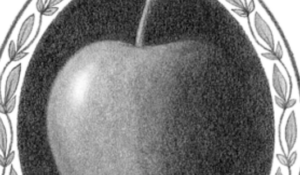In the nineteenth century, if you lived near Albany or Kingston, New York, you might have tasted the Stroat apple. It was “roundish inclined to conic, yellowish green… very tender, rich; brisk subacid, good to very good,” according to the 1905 book The Apples of New York. The Stroat (or Straat) was “formerly much esteemed among the descendants of the Dutch settlers on the North river,” wrote horticulturist S. A. Beach in this volume. Even so, it had already disappeared. “We have not seen this fruit nor has it been mentioned by any of our correspondents” (Beach 1905, 208).
To Carl Pope, executive director of the Sierra Club, who brought this apple to our attention, the loss of the Stroat symbolizes how markets discard what isn’t commercially popular. Thus, he says, they carry a lesson for endangered species.
The extinction of apple varieties isn’t as serious as the loss of, say, a cheetah, he says. “But the pattern demonstrates that private markets will reliably preserve only varieties and species that serve relatively immediate commercial or other human needs. If there is no market for the Stroat apple formerly found in Kingston, New York, it will, and evidently, has, passed away. . . .”(Pope 1998).
Thus, Pope challenges the view that markets can protect species. There are several points to address in his challenge, but this short essay will merely discuss the market for apples.
When people talk about apples, they often echo Pope’s theme that commercial pressures have destroyed diversity. Keith Schneider, formerly a reporter for the New York Times, compared the 14 kinds of old apple trees on his Michigan farm with the “paltry pickings” in supermarkets. “Shelf life, texture, uniform ripening and disease resistance are the most sought-after traits. Distinctive taste is barely in the first tier of breeding goals,” he wrote (Schneider 1998). In a similar vein, Bill Gifford condemned the pervasive Red Delicious apple. “Ubiquitous and mediocre, a gorgeous fraud, the Red Delicious has come to symbolize modern agribusiness at its worst” (Gifford 1998, 22).
Yet, today in the nation’s leading apple-growing state, Red Delicious trees are being ripped out. “We can’t sell Red Delicious because there are better products here,” says a fruit researcher at Washington State University (quoted in Lester and Nelson 1999).
Pink Ladies, Fujis, Braeburns, Granny Smiths, and Royal Galas are shoving Red Delicious out of the nation’s Safeways and Albertson’s. Growers are combing through the 6,000 or so varieties of apples in existence to find new ones. At Little Owl Orchard in Washington State, Doyle and Thelma Fleming hope they have a winner in the new Cameo apple. In case they don’t, their own breeding orchard has 4,000 varieties they can consider (Guterson 1999).
Consumers who can’t wait for new specialties can find obscure apple types at Applesource, a producer offering home delivery of 75 varieties. The owner, Tom Vorbeck, lists on his Web site 43 kinds of apples suited for planting in central Illinois (applesource.com). Tree-Mendus Fruit and Skyline Orchards (tree-mendus.com) in Michigan offer the public 200 varieties.
Growers can find cuttings of old varieties at the Sonoma Antique Apple Nursery in Healdsburg, California. To name a few: the Alexander, a Russian apple that pre-dates 1817; the Baldwin, grown in Massachusetts in 1784; and the Claygate Pearmain, recorded in England in 1821. (With apples, seeds don’t germinate into true varieties; you must graft a cutting of the type you want.)
Perhaps the leading preservers of old apples are heirloom gardeners. “Since the 1970s,” writes Suzanne P. DeMuth (1998, 6) in the Department Agriculture’s four-volume guide to heirlooms, “an expanding popular movement dedicated to perpetuating and distributing these garden classics has emerged among home gardeners and small-scale growers, with interest and endorsement from scientists, historians, environmentalists, and consumers.”
One apple enthusiast is Carlos Manning, a West Virginia mechanic whose hobby is looking for antique apple trees. He has discovered examples of about 300 varieties, including at least two, the Western Beauty and Rainbow, that were thought to be extinct (Amarillo Globe-News, March 21, 2000).
Red, long-lasting apples did take over the market for a stretch of time as people marveled at having good-looking, sweet apples all year. The story of the Red Delicious apple itself illustrates how producers strive to find new varieties. In 1892, Clarence Stark of the Stark Brothers nursery in Louisiana, Missouri, held a national contest to find the best apple. One was so good that when he bit into it he supposedly exclaimed “Delicious! That will be its name” (Terry 1966, 39). Although many consumers are tired of it now, it will live on. The Fuji (the “best-keeping sweet apple in the world,” according to Tom Vorbeck) is a cross between the Red Delicious and the Ralls Janet, an antique apple known to Thomas Jefferson.
As producers constantly try to find what pleases the customer, they discover the special, the interesting and even the old. Yet the Stroat apple disappeared. Why?
The Stroat disappeared too long ago to be a victim of modern commercialism, if that means the advent of supermarkets and nationwide transportation. But most likely it failed the market test. Applesource’s Vorbeck says about heirloom apples that “something was wrong about them, as the market changed, that caused growers not to make money on them anymore” (Gifford 1998, 24).
Saving an apple variety requires a few people who really want it and who are willing to pay someone the price of tending it. But only a few are needed. The majority may prefer bright color and consistent taste, but the minority will seek out distinctive characteristics and unusual flavors. As people have become more wealthy, their span of tastes has increased, as has their ability to satisfy them. The system of production and distribution-growers, distributors, catalogs, breeding orchards-has expanded, too, making it easier to save, ship, and sell antique apples and trees. The price of diversity has gone down.
The Stroat and others have disappeared, but the market saves many, many apples-tart, sweet, yellow, green, red, russet, acidic, nutty, aromatic, juicy, crunchy.
Can the market save the cheetah as well? If there are just enough people willing to care for the cheetah and to pay what is needed to protect it, the answer is yes. And as time goes on, more and more people fit that description.
References
Beach, S. A. 1905. The Apples of New York, vol. 2. Albany, NY: J. B. Lyon Co.
DeMuth, Suzanne. 1998. Vegetables and Fruits: A Guide to Heirloom Varieties an Community-Based Stewardship. Vol. 1, Annotated Bibliography. SRB 98-05. Beltsville, MD: National Agricultural Library, U.S. Department of Agriculture, September.
Gifford, Bill. 1998. Fruits of His Labor. Washington Post Magazine, October 18, 19Ð24.
Guterson, David. 1999. The Kingdom of Apples. Harper’s Magazine, October, 41Ð56.
Lester, David, and Wes Nelson. 1999. Seeds of Change. Yakima Herald-Republic, December 24.
Pope, Carl. 1998. Letters. PERC Reports, September 19.
Schneider, Keith. 1998. In an Old Orchard, Tastes the Supermarket Forgot. New York Times, June 2.
Terry, Dickson. 1966. The Stark Story. A Special Publication of The Bulletin. St. Louis, MO: Missouri Historical Society, September.
Jane S. Shaw is a Senior Associate of PERC and editor of PERC Reports.




